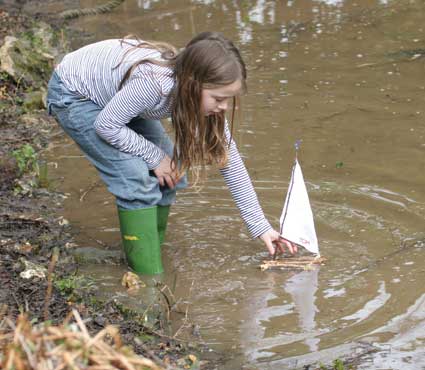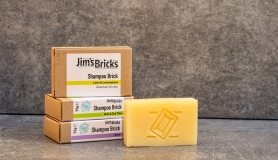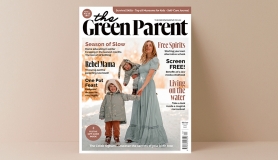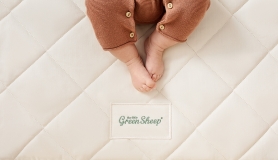*SUPPLIES *
For wooden rafts and boats: small straight branches or twigs, raffia (or string or twine), fabric scraps, needle and thread
For recycled boats: juice or milk carton washing up bottle (any item that floats) discarded paper, twigs, modeling clay
1 The simplest wooden vessel to make is a raft; add a sail and it not only looks more like a boat but the sail will push it across the water. Collect an assortment of small, fallen branches and twigs and look out for straighter wood. Decide how large you want your boat to be, trim the branches to that length and line them up to check the overall size. When you have the size you like, take a long piece of raffia and tie the centre of the length of raffia around the end of one of the trimmed branches. Note: Do not pull the raffia too tight or it might break, it’s okay if the branches are a little loose. Take the ends of the raffia and tie another branch the same way around the end right next to the other one. Keep adding branches and tying them until you’ve tied all of the branches together. Then tie the opposite ends of the branches together with raffia in the same way.
2 Make the boat more stable by tying a support branch across each end of the branches where you tied the raffia. Secure these branches by tying one end with raffia, then thread the raffia around the top branch and down around the lower branches. Continue threading until you reach the end and tie it off. Repeat on the other side of the raft.
Make a sail for your boat by cutting a scrap of cloth into a triangle with a 90-degree angle. You may want to cut the triangle out of a piece of paper first and hold it up to the boat to determine the size sail you want; then use the paper sail for a pattern to cut out the cloth. At this stage >
> you may want to decorate the sailcloth with embroidery or patches.
3 Lay a straight twig over the cloth edge opposite the 90-degree angle and fold the cloth over the twig. Using a needle and thread, stitch the twig to the cloth. Add a twig to the bottom of the sail to create a “boom” and attach it with a needle and thread in a few places. Next take a long twig for a mast. Measure it against the boat to determine the height you’d like it to be and add about 5cm to its base (extra length is needed when you attach the sail to the boat). Stitch the remaining edge of the sail to the mast in a few places and leave a little room at the top for a flag. Stitch a small flag to the top of the mast if you wish. Wedge the sail between two of the twigs of the boat. If the mast is loose, tighten it at the base by tieing raffia tightly around the mast base and the twigs of the boat or wedge in a little modelling clay to tighten it. Set it to sail on a pond, stream, a bowl or the bath.
4 Make boats from recycled materials.
Position a juice carton flat on its side so the triangular part of its top points up and cut off one side. The triangle will form the bow of the boat. Take a piece of paper and cut out two pirate ship style sails, one slightly smaller than the other.
5 Trim a stick to the right length to form a mast and thread the sails on to the twig, the largest first. A flag can be attached to the top of the mast.
6 Roll a ball of modelling clay in your hands and centre it in the bottom of the carton and stick it down; then push the mast into the ball of clay.
Note: Boat making is a great summertime activity for a group of children, just provide a pile of parts and see what they build. After the building, hold a regatta. In addition to the boats, small sailors and pirates can be made using materials that float, like clothes pegs or empty thread spools with wooden beads for heads.
Download a template for the sails here







